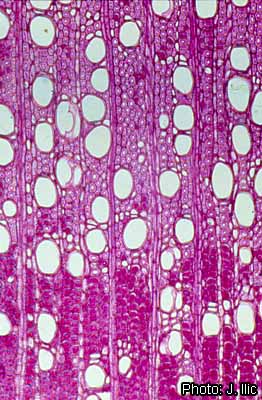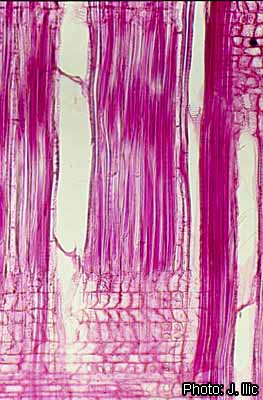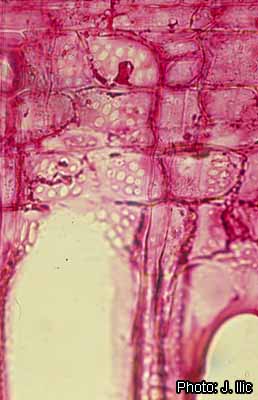Difference between revisions of "Cassipourea malosana (PROTA)"
| Line 12: | Line 12: | ||
wild | wild | ||
1, flowering twig; 2, flower; 3, part of fruiting twig; 4, fruit. Redrawn and adapted by Iskak Syamsudin | 1, flowering twig; 2, flower; 3, part of fruiting twig; 4, fruit. Redrawn and adapted by Iskak Syamsudin | ||
| − | [[File:Cassipourea malosana R. Copeland.jpg|thumb| | + | [[File:Cassipourea malosana R. Copeland.jpg|thumb|young fruits]] |
[[File:Cassipourea malosana 2572(A)trans.jpg|thumb|wood in transverse section]] | [[File:Cassipourea malosana 2572(A)trans.jpg|thumb|wood in transverse section]] | ||
[[File:Cassipourea malosana 2572(C) rad.jpg|thumb|wood in radial section]] | [[File:Cassipourea malosana 2572(C) rad.jpg|thumb|wood in radial section]] | ||
Revision as of 23:39, 3 February 2015
Introduction |
| General importance | |
| Geographic coverage Africa | |
| Geographic coverage World | |
| Carbohydrate / starch | |
| Medicinal | |
| Timber | |
| Fuel | |
| Ornamental | |
wild
1, flowering twig; 2, flower; 3, part of fruiting twig; 4, fruit. Redrawn and adapted by Iskak Syamsudin
Cassipourea malosana (Baker) Alston
- Protologue: Bull. Misc. Inform. Kew 1925: 258 (1925).
- Family: Rhizophoraceae
Synonyms
Cassipourea elliottii (Engl.) Alston (1925), Cassipourea congoensis auct. non DC.
Vernacular names
Pillarwood, common onionwood, bastard onionwood (En).
Origin and geographic distribution
Cassipourea malosana occurs from eastern DR Congo and Ethiopia south to South Africa.
Uses
The wood of Cassipourea malosana is traded as pillarwood. It is suitable for construction, flooring (especially heavy duty or industrial flooring), vehicle bodies, furniture and cabinet work, tool handles, ladders, sporting goods, agricultural implements, joinery, sleepers, poles and piles, toys and novelties, beehives, turnery, and for veneer and plywood. Its low durability, however, limits its applicability outdoors. Nevertheless, Cassipourea malosana is an important timber tree in East Africa. The wood is also used as firewood.
The Loita Maasai people in Kenya eat the outer bark boiled with soup to gain strength. Tea is made from the scraped inner bark; it is drunk by women to help to remove the placenta. In South Africa the bark is used as a skin lightener, and to treat skin ailments and sunburn. The flowers are a good source of nectar for bees. Cassipourea malosana is also used as a shade tree.
Properties
The heartwood varies in colour, from whitish to brown, often with purple streaks associated with fungal attack; it is indistinctly demarcated from the sapwood. The grain is usually straight, but with a slight to marked tendency to spiralling; texture fine and even. Freshly cut wood smells like onion. The wood has a density of 600–840 kg/m³ at 12% moisture content. Shrinkage rates are 3.5% radial and 8.0% tangential from green to 12% moisture content. The wood is refractory in seasoning due to high shrinkage and the presence of spiral grain. It dries slowly and is subject to severe distortion, particularly twist; checking is slight. At 12% moisture content, the modulus of rupture is 93–123 N/mm², modulus of elasticity 11,500–12,500 N/mm², compression parallel to grain 61–76 N/mm², shear 9.8–18.5 N/mm², cleavage 16–79 N/mm radial and 30–114 N/mm tangential, and Janka side hardness 5960–7345 N.
The green timber may be difficult to saw as it has a strong tendency to spring. Dry wood is easier to work than green wood. The wood is resistant to wear and abrasion. It is moderately easy to work using hand tools and has excellent machining properties, especially in moulding, but it may have an appreciable blunting effect on tool edges. A good finish can be obtained. The wood tends to split on nailing, and pre-boring is necessary. The wood may be somewhat troublesome to glue and is not suitable for steam bending.
The durability is low. The wood is susceptible to attacks by termites and Lyctus borers. The heartwood is resistant to impregnation, the sapwood moderately resistant.
Description
Evergreen shrub or small to large tree up to 45 m tall; bole up to 21 m long, straight, cylindrical, up to 60 cm in diameter, without buttresses; bark grey, greyish yellow or brown, smooth, inner layer of outer bark bright red on exposure, inner bark orange with white striations, exudate watery; crown small, rounded; young branches hairy, later glabrous. Leaves opposite, simple; stipules between the petioles, 2–5 mm long; petiole 2–8 mm long; blade oblanceolate, lanceolate, elliptical, oblong, ovate or obovate, 2.5–10 cm × 1–6 cm, base cuneate or obtuse, apex obtuse to acute or acuminate, margin toothed or rarely entire, shiny and glabrous above, dull and sparsely pubescent to glabrous below. Inflorescence an axillary fascicle, lax to congested, 1–5(–8)-flowered. Flowers bisexual, regular, 4–5(–6)-merous; pedicel 2–6(–9) mm long, jointed near apex; calyx with tube 0.5–2 mm long, lobes narrowly oblong-triangular, 3–6 mm long, hairy outside; petals spatulate, 4–8 mm long, deeply fringed, white, yellowish or greenish; stamens 15–20(–22); ovary superior, glabrous to apically hairy, 3–4-celled, style 3–5 mm long and persistent. Fruit an ellipsoid to ovoid capsule 6–10 mm × 4–6 mm, black when dry, hairy but becoming almost glabrous, dehiscent, few-seeded. Seeds with aril, testa leathery.
Other botanical information
Cassipourea comprises about 70 species, widely distributed in the tropics. The wood of Cassipourea ndando J.Léonard ex Floret, occurring in DR Congo, Rwanda, Burundi and Zambia in forest at 1650–2500 m altitude, is also used for carpentry.
The boles of many large Cassipourea malosana trees are rotten inside.
Anatomy
Wood-anatomical description (IAWA hardwood codes):
- Growth rings: 2: growth ring boundaries indistinct or absent.
- Vessels: 5: wood diffuse-porous; (9: vessels exclusively solitary (90% or more)); 13: simple perforation plates; (14: scalariform perforation plates); (15: scalariform perforation plates with ≤ 10 bars); 21: intervessel pits opposite; 22: intervessel pits alternate; 25: intervessel pits small (4–7 μm); 26: intervessel pits medium (7–10 μm); 31: vessel-ray pits with much reduced borders to apparently simple: pits rounded or angular; 32: vessel-ray pits with much reduced borders to apparently simple: pits horizontal (scalariform, gash-like) to vertical (palisade); 41: mean tangential diameter of vessel lumina 50–100 μm; 49: 40–100 vessels per square millimetre; 58: gums and other deposits in heartwood vessels.
- Tracheids and fibres: 62: fibres with distinctly bordered pits; 63: fibre pits common in both radial and tangential walls; 66: non-septate fibres present; 69: fibres thin- to thick-walled; (70: fibres very thick-walled).
- Axial parenchyma: 76: axial parenchyma diffuse; 77: axial parenchyma diffuse-in-aggregates; 78: axial parenchyma scanty paratracheal; 93: eight (5–8) cells per parenchyma strand; 94: over eight cells per parenchyma strand.
- Rays: (97: ray width 1–3 cells); (98: larger rays commonly 4- to 10-seriate); (102: ray height > 1 mm); (103: rays of two distinct sizes); 108: body ray cells procumbent with over 4 rows of upright and/or square marginal cells; 109: rays with procumbent, square and upright cells mixed throughout the ray; 115: 4–12 rays per mm; 116: ≥ 12 rays per mm.
- Mineral inclusions: 136: prismatic crystals present; 137: prismatic crystals in upright and/or square ray cells.
(L.N. Banak, H. Beeckman & P.E. Gasson)
Ecology
Cassipourea malosana mostly occurs in dry or humid forest at 1000–3100 m altitude. It is locally common, and in montane forests in Kenya and Tanzania it is sometimes the dominant species or co-dominant with Podocarpus latifolius (Thunb.) Mirb.
Propagation and planting
Cassipourea malosana is sometimes propagated by wildlings collected from the forest.
Genetic resources
In view of its wide distribution Cassipourea malosana is not liable to genetic erosion.
Prospects
Although the wood is not durable, not easy to work and prone to deformation during drying, Cassipourea malosana is an important local source of timber in East Africa and will probably remain so.
Major references
- Beentje, H.J., 1994. Kenya trees, shrubs and lianas. National Museums of Kenya, Nairobi, Kenya. 722 pp.
- Bolza, E. & Keating, W.G., 1972. African timbers: the properties, uses and characteristics of 700 species. Division of Building Research, CSIRO, Melbourne, Australia. 710 pp.
- Chudnoff, M., 1980. Tropical timbers of the world. USDA Forest Service, Agricultural Handbook No 607, Washington D.C., United States. 826 pp.
- Friis, I., 1995. Rhizophoraceae. In: Edwards, S., Mesfin Tadesse & Hedberg, I. (Editors). Flora of Ethiopia and Eritrea. Volume 2, part 2. Canellaceae to Euphorbiaceae. The National Herbarium, Addis Ababa University, Addis Ababa, Ethiopia and Department of Systematic Botany, Uppsala University, Uppsala, Sweden. pp. 133–134.
- Lovett, J.C., Ruffo, C.K. & Gereau, R.E., 2003. Field guide to the moist forest trees of Tanzania. [Internet] Centre for Ecology Law and Policy, Environment Department, University of York, York, United Kingdom. http://www.york.ac.uk/ res/celp/webpages/projects/ecology/ tree%20guide/guide.htm. December 2005.
- Lavers, G.M., 1969. The strength properties of timbers. Bulletin No 50 (2nd edition, metric units). Ministry of Technology, Forest Products Research, London, United Kingdom. 62 pp.
- Lewis, J., 1956. Rhizophoraceae. In: Turrill, W.B. & Milne-Redhead, E. (Editors). Flora of Tropical East Africa. Crown Agents for Oversea Governments and Administrations, London, United Kingdom. 20 pp.
- Oxford Forestry Institute, 1997–2004. Prospect: the wood database for Windows. Version 2.1. [Internet] University of Oxford, Oxford, United Kingdom. http://www.plants.ox.ac.uk/ ofi/prospect/ index.htm. December 2007.
- Torre, A.R. & Gonçalves, A.E., 1978. Rhizophoraceae. In: Launert, E. (Editor). Flora Zambesiaca. Volume 4. Flora Zambesiaca Managing Committee, London, United Kingdom. pp. 81–99.
- World Agroforestry Centre, undated. Agroforestree Database. [Internet] World Agroforestry Centre (ICRAF), Nairobi, Kenya. http://www.worldagroforestry.org/ Sites/TreeDBS/ aft.asp. December 2005.
Other references
- Bryce, J.M., 1967. The commercial timbers of Tanzania. Tanzania Forest Division, Utilisation Section, Moshi, Tanzania. 139 pp.
- Dale, I.R. & Greenway, P.J., 1961. Kenya trees and shrubs. Buchanan’s Kenya Estates Limited, Nairobi, Kenya. 654 pp.
- Friis, I., 1993. Rhizophoraceae. In: Thulin, M. (Editor). Flora of Somalia. Volume 1. Pteridophyta; Gymnospermae; Angiospermae (Annonaceae-Fabaceae). Royal Botanic Gardens, Kew, Richmond, United Kingdom. pp. 254–258.
- Gonçalves, A.E. & Torre, A.R., 1979. Rhizophoraceae. In: Mendes, E.J. (Editor). Flora de Moçambique. No 67. Junta de Investigações Científicas do Ultramar, Lisbon, Portugal. 21 pp.
- InsideWood, undated. [Internet] http://insidewood.lib.ncsu.edu/search/. May 2007.
- Liben, L., 1987. Rhizophoraceae. In: Bamps, P. (Editor). Flore d’Afrique centrale. Spermatophytes. Jardin botanique national de Belgique, Brussels, Belgium. 36 pp.
- Maundu, P., Berger, D., Saitabau, C., Nasieku, J., Kipelian, M., Mathenge, S., Morimoto, Y. & Höft, R., 2001. Ethnobotany of the Loita Maasai. Towards community management of the forest of the Lost Child. Experiences from the Loita Ethnobotany Project. UNESCO People and Plants Working Paper 8, Paris, France. 34 pp.
- Neuwinger, H.D., 2000. African traditional medicine: a dictionary of plant use and applications. Medpharm Scientific, Stuttgart, Germany. 589 pp.
- Scott, M.H., 1950. Notes on the more important African timbers imported into the Union with special reference to Portuguese East African species. Journal of the South African Forestry Association 19: 18–62.
- Sommerlatte, H. & Sommerlatte, M., 1990. A field guide to the trees and shrubs of the Imatong Mountains, southern Sudan. Deutsche Gesellschaft fur Technische Zusammmenarbeit (GTZ), Nairobi, Kenya. 372 pp.
- Takahashi, A., 1978. Compilation of data on the mechanical properties of foreign woods (part 3) Africa. Shimane University, Matsue, Japan, 248 pp.
- Tanzania Forest Division, 1967. The weights and shrinkage of some local timbers. Revised edition. Technical Note No 26. Tanzania Forest Division, Utilisation Section, Moshi, Tanzania. 5 pp.
- van Wyk, B.E. & Gericke, N., 2000. People’s plants: a guide to useful plants of southern Africa. Briza Publications, Pretoria, South Africa. 351 pp.
- Wimbush, S.H., 1957. Catalogue of Kenya timbers. 2nd reprint. Government Printer, Nairobi, Kenya. 74 pp.
Sources of illustration
- Dale, I.R. & Greenway, P.J., 1961. Kenya trees and shrubs. Buchanan’s Kenya Estates Limited, Nairobi, Kenya. 654 pp.
Author(s)
- M. Brink
PROTA Network Office Europe, Wageningen University, P.O. Box 341, 6700 AH Wageningen, Netherlands
Correct citation of this article
Brink, M., 2006. Cassipourea malosana (Baker) Alston. [Internet] Record from PROTA4U. Louppe, D., Oteng-Amoako, A.A. & Brink, M. (Editors). PROTA (Plant Resources of Tropical Africa / Ressources végétales de l’Afrique tropicale), Wageningen, Netherlands. <http://www.prota4u.org/search.asp>.
Accessed 5 April 2025.
- See the Prota4U database.





